
Luigi is a fictional character featured in video games and related media released by Nintendo. Created by Japanese video game designer Shigeru Miyamoto, Luigi is portrayed as an Italian plumber and the younger fraternal twin brother and sidekick of Mario. Defined by his kind-hearted, yet cowardly demeanor, Luigi appears in many games throughout the Mario franchise, oftentimes accompanying his brother.

Yoshi is a fictional dinosaur who appears in video games published by Nintendo. Yoshi debuted in Super Mario World (1990) on the SNES as Mario and Luigi's sidekick. Throughout the mainline Super Mario series, Yoshi typically serves as Mario's trusted steed. With a gluttonous appetite, Yoshi can gobble enemies with his long tongue, and lay eggs that doubly function as projectiles. Yoshi is the title character of the Yoshi series and a supporting character in Mario spin-off games such as Mario Party and Mario Kart, as well as many Mario sports games. He also appears as a playable character in the crossover fighting game series Super Smash Bros. Yoshi is a member of the same-named species, which is distinguished for its wide range of colors.

Princess Peach is a character in Nintendo's Mario franchise. She was created by Shigeru Miyamoto and introduced in the 1985 original Super Mario Bros. game as Princess Toadstool. She is the princess regnant and head of state of the Mushroom Kingdom, where she resides in her castle along with Toads. Since her debut, she has appeared in the majority of Mario video games as the main female character and the romantic interest of Mario. She has been voiced by Samantha Kelly since 2007.

Bowser, also known as King Bowser or King Koopa, is a fictional character and the main antagonist of Nintendo's Mario franchise. In Japan, his title is Daimaō. He is the arch-nemesis of the plumber Mario, and the leader of the turtle-like Koopa race. Bowser's defining traits are his monstrous appearance with dragon-like elements, full-throated roar, fire-breathing abilities, and tyrannical personality. His ultimate goals are to kidnap Princess Peach, make her his queen, and conquer the Mushroom Kingdom, and eventually the world.

Paper Mario is a 2000 role-playing game developed by Intelligent Systems and published by Nintendo for the Nintendo 64 home video game console. Paper Mario is the first game in the Paper Mario series. First released in Japan in 2000 and then internationally in 2001, Paper Mario was later re-released for Nintendo's Wii Virtual Console in July 2007, the Wii U Virtual Console in April 2015, and the Nintendo Switch Online + Expansion Pack on December 10, 2021.
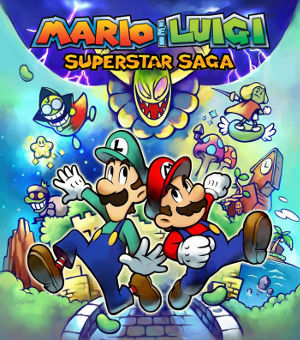
Mario & Luigi: Superstar Saga is a 2003 role-playing game developed by AlphaDream and published by Nintendo for the Game Boy Advance. It was re-released for the Wii U's Virtual Console in 2014, Nintendo Switch Online Service in 2023, and remade for the Nintendo 3DS as Mario & Luigi: Superstar Saga + Bowser's Minions in 2017. In the game, Mario and Luigi travel to the Beanbean Kingdom in order to combat Cackletta and Fawful, who stole Princess Peach's voice for the purpose of harnessing the power of a special artifact called the Beanstar.

Super Mario 64 DS is a 2004 platform game developed and published by Nintendo for the Nintendo DS. It was a launch game for the DS. Super Mario 64 DS is a remake of the 1996 Nintendo 64 game Super Mario 64, with new graphics, characters, collectibles, a multiplayer mode, and several extra minigames. As with the original, the plot centers on rescuing Princess Peach from Bowser. Unlike the original, Yoshi is the first playable character, with Mario, Luigi, and Wario being unlockable characters in early phases of the game.
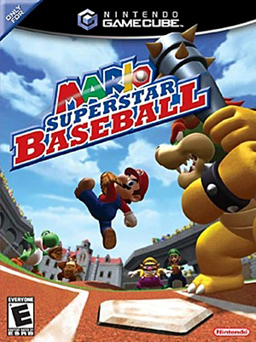
Mario Superstar Baseball is a 2005 sports video game developed by Namco and published by Nintendo for the GameCube. The game was created in the vein of other Mario sports games such as Mario Golf: Toadstool Tour and Mario Power Tennis. A sequel, Mario Super Sluggers, was released for the Wii in 2008.
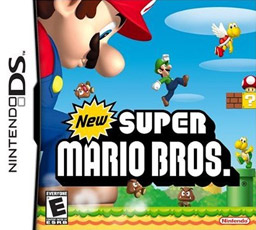
New Super Mario Bros. is a 2006 platform game developed and published by Nintendo for the Nintendo DS. It was first released in May 2006 in North America and Japan, and in PAL regions in June 2006. It is the first installment in the New Super Mario Bros. subseries of the Super Mario franchise and follows Mario as he fights his way through Bowser's henchmen to rescue Princess Peach. Mario has access to several old and new power-ups that help him complete his quest, including the Super Mushroom, the Fire Flower, and the Super Star, each giving him unique abilities. While traveling through eight worlds with more than 80 levels, Mario has to defeat Bowser Jr. and Bowser before saving Princess Peach.

Super Princess Peach is a 2005 platform game developed by Tose and published by Nintendo for the Nintendo DS. It was released in Japan in October 2005 and worldwide the following year. Super Princess Peach is the first game to feature Princess Peach as the main protagonist on a dedicated video game console and the second overall after Princess Toadstool's Castle Run released in 1990 on the Nelsonic Game Watch.

Yoshi's Island DS, known in Japan as Yoshi Island DS, is a 2006 platform game developed by Artoon and published by Nintendo for the Nintendo DS. It was released in North America and Australia in November 2006, in Europe in December 2006, and in Japan in March 2007. It is a sequel to the 1995 SNES game, Super Mario World 2: Yoshi's Island. Announced at Nintendo's E3 press conference in May 2006, the game was well received by critics, scoring an average of 81% on Metacritic's aggregate. The game was originally to be titled Yoshi's Island 2, though its name was changed one month before its North American release. In April and May 2015, the game was made available for the Wii U via the Virtual Console service, shortly after a Nintendo Direct presentation.

Super Mario is a platform game series created by Nintendo starring their mascot, Mario. It is the central series of the greater Mario franchise. At least one Super Mario game has been released for every major Nintendo video game console. However, there have also been a number of Super Mario video games released on non-Nintendo gaming platforms. There are more than 20 games in the series.

Mario & Luigi: Bowser's Inside Story is a 2009 role-playing game developed by AlphaDream and published by Nintendo for the Nintendo DS handheld game console. It is the third game in the Mario & Luigi role-playing series. It uses the interactive screens of the DS in some of its gameplay mechanics while also introducing several elements that would be used in the series' future gameplay.

Mario is a Japanese multimedia franchise created by Japanese game designer Shigeru Miyamoto for video game company Nintendo, which produces and publishes its installments. Starring the titular Italian plumber Mario, it is primarily a video game franchise but has extended to other forms of media, including television series, comic books, a 1993 feature film, a 2023 animated film, and theme park attractions. The series' first installment was 1983's Mario Bros., although Mario made his first appearance in 1981's arcade game Donkey Kong and had already been featured in several games of the Donkey Kong and Game & Watch series. The Mario games have been developed by a wide variety of developers, including Nintendo, Hudson Soft, and AlphaDream. Mario games have been released almost exclusively for Nintendo's various video game consoles and handhelds, from the third generation onward.

Toad, known in Japan as Kinopio, is a character from the Mario franchise. The character was created by Japanese video game designer Shigeru Miyamoto, and is portrayed as a citizen of the Mushroom Kingdom and one of Princess Peach's attendants. Toad is typically a non-player character who assists Mario and his friends, but he occasionally appears as a protagonist.
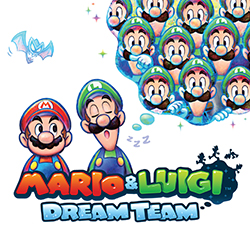
Mario & Luigi: Dream Team, known in Europe and Australia as Mario & Luigi: Dream Team Bros., is a 2013 role-playing video game developed by AlphaDream and published by Nintendo for the Nintendo 3DS. It is the fourth installment in the Mario & Luigi series, a part of the larger Mario franchise. The game's story follows Mario and his brother Luigi who, after being invited to Pi'illo Island for a vacation, become embroiled in a journey to retrieve a powerful artifact before Bowser and Antasma use it for evil intentions. The gameplay takes place from a top-down perspective and has the player controlling Mario and Luigi simultaneously, solving puzzles and platformer sessions, and overcoming turn-based battles across Pi'illo Island, the game's overworld. The player also makes use of Luigi's dreams, called the "Dream World", where gameplay shifts to a two-dimensional side-scrolling perspective and emphasizes using Luigi-based gimmicks to their advantage. Combat in both worlds is turn-based.
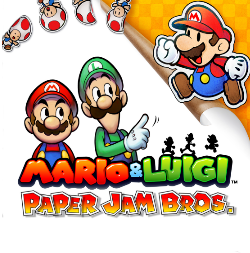
Mario & Luigi: Paper Jam, known in Europe and Australia as Mario & Luigi: Paper Jam Bros., is a 2015 role-playing video game developed by AlphaDream and published by Nintendo for the Nintendo 3DS console. It is the fifth installment in the Mario & Luigi series, and serves as a crossover between the Mario & Luigi and Paper Mario series, the latter being a cross-genre series developed by Intelligent Systems. In Paper Jam, Luigi accidentally opens a book containing the Paper Mario universe, causing all of its contents to spread into the Mushroom Kingdom; Mario and Luigi, with the help of the befriended Paper Mario, venture to save both Princess Peach universe variants from Bowser, who has teamed up with his paper counterpart as well. In the game, the player controls the trio simultaneously through an overworld to reach Bowser's Castle, and fights enemies in turn-based combat along the way.
Mario & Luigi is a series of role-playing video games developed by AlphaDream and published by Nintendo for the latter's various video game handheld consoles. The series is a spin-off from Nintendo's trademark Super Mario series and stars the titular characters Mario and Luigi. The games' stories follow the two on a quest to defeat an antagonist, sometimes Bowser but usually a new character. It began in 2003 on the Game Boy Advance with Mario & Luigi: Superstar Saga, with the latest original installment being Mario & Luigi: Paper Jam in 2015 for the Nintendo 3DS. Two other titles in the series, including Superstar Saga, had an additional remake for the Nintendo 3DS. Mario & Luigi: Bowser's Inside Story + Bowser Jr.'s Journey was the last game in the series before AlphaDream declared bankruptcy in 2019, and remains the latest installment in the series.
















